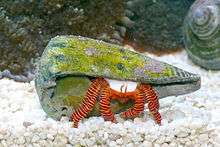Halloween hermit crab
| Halloween hermit crab | |
|---|---|
 | |
| Scientific classification | |
| Kingdom: | Animalia |
| Phylum: | Arthropoda |
| Subphylum: | Crustacea |
| Class: | Malacostraca |
| Order: | Decapoda |
| Superfamily: | Paguroidea |
| Family: | Diogenidae |
| Genus: | Ciliopagurus |
| Species: | C. strigatus |
| Binomial name | |
| Ciliopagurus strigatus (Herbst, 1804)[1] | |
| Synonyms [2] | |
| |
The halloween hermit crab, Ciliopagurus strigatus, also known as the striped hermit crab[3] or orange legged hermit crab,[4] is a brightly colored aquatic hermit crab of the family Diogenidae. Besides its ability to routinely clean algae in aquariums, the halloween hermit crab's festive striped coloration also appeals to enthusiasts;[5] it is considered the most brightly colored hermit crab in normal aquarium use.[6]
Characteristics
The halloween hermit crab is commonly found along coral substrates and in the ocean,[7] along sandy areas surrounding reefs, but not typically on top of the reefs themselves,[4] in shallow (less than 50 feet or 15 metres) tropical, coastal waters.[8] It is believed to have originated from the Hawaiian region[6][9] and is native to the Indo-Pacific region, including the Red Sea.[3] It is very similar in appearance to three other species in the same genus: C. tricolor, C. vakovako and C. galzini, only distinguishable by the color of its striae.[10]
The halloween hermit crab will grow on average to 2 inches (5.1 cm) in length,[3][8] which is fairly large in comparison to other hermit crabs.[6] It has a noticeably flattened pure white shield, approximately .315 inches (8 mm) long.[11] It is a nocturnal species,[3] and has been described as "conspicuous".[11] It lives primarily in empty cone shells,[3] mainly those of snails or tritons.[9] Like other hermit crabs, it wears shells in order to protect itself from predators.[8] Its ocular peduncles and antennae are a solid orange and the antennal flagella are transparent. The corneous has parallel ridges on the palm, with similar ridges on the crabs' dactals (the movable part of their pincers).[7] The halloween hermit crab can live for up to 10 years.[6][8]
Coloration
The halloween hermit crab is well known for its distinct and vibrant coloration.[8] It has been described as an unusual hermit crab[12] and the brightest of the hermit crabs typically available,[5] with vividly colored walking legs,[12] a red body, and alternating horizontal bright orange and white bands,[8] giving it the likeness of the festive colors[5] of Halloween.[8] These characteristics make the Halloween hermit crab attractive to aquarists.[5]
Diet
The halloween hermit crab is omnivorous[6] and a scavenger,[4] eating nearly anything that appears in its environment,[6] including small animals.[4] It feeds on live and dead animal material,[3] including filamentous algae and detritus.[6] If a halloween hermit crab's shell is too small, it may attack a snail for a larger shell.[9] The halloween hermit crab can eat quickly.[13]
Use in aquariums
Aquarium owners may like to use the halloween hermit crab because it is visually unlike other aquarium cleaning crabs. It can eat any left-over food that settles along the bottom, sifts through the sand which aerates the aquarium substrate and is well known to eat cyanobacteria, unsightly brown bacteria, and filamentous green algae efficiently. However, because it can become aggressive towards other tank animals and may even kill fish and other invertebrates,[6] it is wise to feed it meats, such as clams, mussels, scallops and shrimp along with various vegetation.[4] Overall, it can support a healthy aquarium environment.[9]
References
- ↑ "Ciliopagurus strigatus". Integrated Taxonomic Information System. Retrieved August 25, 2010.
- ↑ Patsy McLaughlin (2009). P. McLaughlin, ed. "Ciliopagurus strigatus (Herbst, 1804)". World Paguroidea database. World Register of Marine Species. Retrieved August 25, 2010.
- 1 2 3 4 5 6 Fenner, Bob. "Best Hermit Crab Species for Algae Control". Hermit Crabs, Use in the Marine Aquarium Hobby. WetWebMedia. Retrieved 21 August 2010.
- 1 2 3 4 5 "Halloween Hermit Crab". Crabs. Blue Zoo Aquatics. Retrieved 21 August 2010.
- 1 2 3 4 "Halloween Hermit Crab". Saltwater Aquarium Cleaner Crabs. Aquatic Connection. Retrieved 21 August 2010.
- 1 2 3 4 5 6 7 8 Dunder, Jonathon. "Halloween Hermit Crab". Aquaripure. Free Information Society. Retrieved 21 August 2010.
- 1 2 Richmond, Matthew D. (1997). A guide to the seashores of Eastern Africa and the Western Indian ocean islands. SIDA/Department for Research Cooperation, SAREC. p. 220.
- 1 2 3 4 5 6 7 "Different Species of Hermit Crabs around the World". Hermit Crab Club. Retrieved 21 August 2010.
- 1 2 3 4 "Halloween Hermit Crab". LiveAquaria. Retrieved 21 August 2010.
- ↑ Poupin, Joseph; Maria Celia Malay (2009). "Identification of a Ciliopagurus strigatus (Herbst, 1804) species-complex, with description of a new species from French Polynesia (Crustacea, Decapoda, Anomura, Diogenidae)" (PDF). Zoosystema. 31 (2).
- 1 2 Davie, P. J. F. (2002). Zoological catalogue of Australia: Crustacea: Malocostraca: Eucarida (Part 2), Decapoda: Anomura, Brachyura. CSIRO Publishing. p. 43.
- 1 2 Hoover, John P. (1998). Hawaii's sea creatures: a guide to Hawaii's marine invertebrates. Mutual Pub. p. 252. Retrieved 21 August 2010.
- ↑ Freshwater and marine aquarium , Volume 22, Issues 7-12. R/C Modeler Corp. Retrieved 21 August 2010.